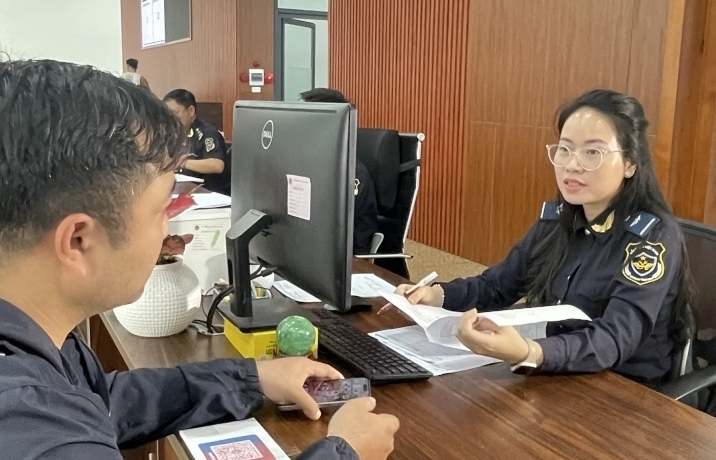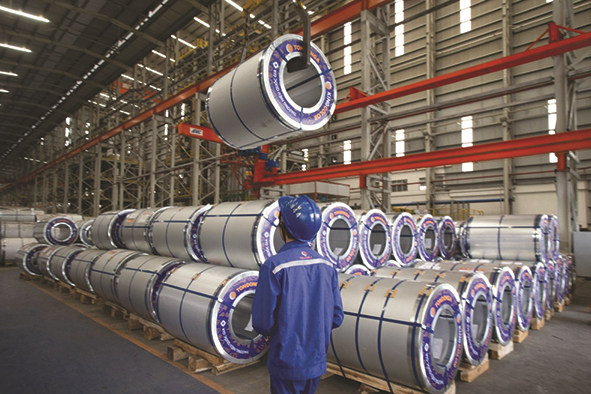Large shift of agricultural product exports by sea
| Korean and Japanese agricultural products and food enter Vietnam | |
| Towards stronger export of agricultural products in 2022 | |
| Develop smooth logistics to circulate goods |
 |
| Tran Thanh Hai, Deputy Director of the Import-Export Department (Ministry of Industry and Trade). |
In the past few days, the congestion of agricultural products at the border gates is an issue in many forums, receiving the attention of a large number of people. In your opinion, why do Vietnamese agricultural products still mainly go to China by land rather than by sea?
First of all, it must be said that among modes of transport, road is still considered the most flexible and mobile mode of transport, which can deliver "door-to-door".
In other words, dragon fruit, mango and jackfruit from the garden are loaded onto the truck and can travel straight to the border after 2-3 days, without requiring transshipment.
If there is no difficulty in customs clearance, the same vehicle will pass through the border gate, deliver the goods to the partner and then return.
Besides, the truck is also suitable for small volumes, at about 20 tons each, suitable for the scale and needs of the farm owners and gardeners. If there is no congestion, a watermelon truck after being sold, minus transportation costs, can still collect hundreds of millions of VND; not to mention higher value fruits such as dragon fruit, mango and jackfruit.
However, the land border gate has limited capacity and is prone to traffic jams, even when fruit is not in the main season because, besides agricultural products, many other goods also travel by road.
When congested, industrial goods and minerals can still wait. Agricultural products will degrade every day, facing the pressure of consumption and disposal, then people will think of other modes of transport.
The road through the auxiliary border gate is even riskier. This is because the secondary border gate is just a form of commerce managed by the local government across the border, not by the central government such as international border gates or main border gates, so the policy may change.
In fact, China also has a policy of narrowing the quota. In recent times, the Chinese side has closed many openings, even built fences along the border to limit residents' passage and trade.
Many people think that the shift of agricultural exports to China by sea is an important and feasible solution. Can you tell us more clearly about the export of goods by sea to China?
According to statistics of the Maritime Administration (the Ministry of Transport), there are about 30 shipping lines operating from Vietnam to China, but the capacity is different.
Not only Asian shipping lines such as Cosco, SITC, CUL, SJS (China); Yang Ming, Wan Hai, Evergreen (Taiwan, China); Heung-A, Sinokor, CK Line, KMTC (South Korea), but also shipping lines from Europe such as SeaLand (a branch of Maersk), CNC (CMA CGM) and ZIM.
The Chinese ports that ships from Vietnam have visited include Qinzhou, Nansha, Yantian, Shekou, Ningbo, Shanghai, Qingdao, Tianjin, Dalian, in order from South to North. Not to mention, Hong Kong (China) is a large transshipment port, which has goods entering China.
In terms of geographical area, there is a difference between the North and the South's agricultural exports by sea. The North mainly exports vegetables such as cabbage, carrots, and chili peppers. These are seasonal agricultural products. The South mainly exports fruits.
Not all agricultural products must use refrigerated containers, but when transporting refrigerated containers by sea, you should know that containers require an electrical outlet to maintain the cold temperature. Each container ship can only have a maximum of 20% of the space on the ship with a reefer socket. If the demand for transporting agricultural products increases suddenly, it is unlikely that the ship owner can receive the transport because there is no room for refrigerated containers on the ship.
In terms of the rate of using refrigerated containers, Vietnam is a powerhouse of agricultural products, with a large volume of exported agricultural products (including aquatic products), so there is a high demand for refrigerated containers to pack goods. Meanwhile, Vietnam's imports in refrigerated containers are quite low (mainly some fruits, meat, aquatic materials).
Therefore, there is an imbalance in refrigerated containers, if they want to bring refrigerated containers to serve Vietnamese shippers, shipping companies must transport empty refrigerated containers from abroad, incurring additional charges.
What is the solution to shift the export of agricultural products from road to sea, sir?
First of all, converting from exporting goods by road to sea must be about changing the mindsets of many gardeners, farm owners, traders and businesses.
It is not that businesses and traders do not know the risks of informal export, but they are afraid to change. They are used to selling goods within a week to receive money immediately. Or maybe they lack the motivation to change.
After this difficult time, how many businesses, traders, farm owners and gardeners think of recruiting professional salespeople, knowledgeable about international trade, mastering skills in marketing, trade promotion, to be able to find new customers located deep in the continent instead of just border traders?
How many of them think of hiring a logistics business to advise and help with chartering services, customs clearance, buying insurance for future shipments. It will be difficult if they are still keeping the old methods. And if businesses have been determined to change, with the support of the authorities and associations, the answer is within reach.
Thank you, sir!
Related News

Customs strictly controls tax evasion tricks in steel imports
09:22 | 25/11/2024 Anti-Smuggling

Initiative to disseminate legal policies using QR codes
09:01 | 24/11/2024 Customs
Latest News

New step in tracing seafood origin, meeting export requirements
09:21 | 25/11/2024 Import-Export

Việt Nam's pangasius exports expected to reach $2b in 2024
18:20 | 24/11/2024 Import-Export

VN’s first pharmaceutical industrial park to be built
18:10 | 24/11/2024 Import-Export

Accelerating investment to meet "green" standards
09:02 | 24/11/2024 Import-Export
More News

US initiates investigation into pharmaceutical capsule shells imported from Việt Nam
17:50 | 23/11/2024 Import-Export

UKVFTA gives advantages to Vietnamese fishery products in the UK, urging focus on quality for further expansion
17:47 | 23/11/2024 Import-Export

Agricultural, forestry and fishery trade surplus value shoots up
10:54 | 23/11/2024 Import-Export

New export and business cooperation opportunities from "dual conversion"
10:53 | 23/11/2024 Import-Export

VN's food processing industry struggles to improve quality and value chain integration
15:53 | 22/11/2024 Import-Export

Approach strategy of the seafood industry when implementing UKVFTA
09:26 | 22/11/2024 Import-Export

Mid-November: Vietnam's trade volume matches 2023 total, eyes record-breaking growth
09:25 | 22/11/2024 Import-Export

Vietnamese enterprises facing challenges from cross-border e-commerce platforms
14:32 | 21/11/2024 Import-Export

Vietnam, Malaysia eye new milestone in trade ties
14:29 | 21/11/2024 Import-Export
Your care

New step in tracing seafood origin, meeting export requirements
09:21 | 25/11/2024 Import-Export

Việt Nam's pangasius exports expected to reach $2b in 2024
18:20 | 24/11/2024 Import-Export

VN’s first pharmaceutical industrial park to be built
18:10 | 24/11/2024 Import-Export

Accelerating investment to meet "green" standards
09:02 | 24/11/2024 Import-Export

US initiates investigation into pharmaceutical capsule shells imported from Việt Nam
17:50 | 23/11/2024 Import-Export





